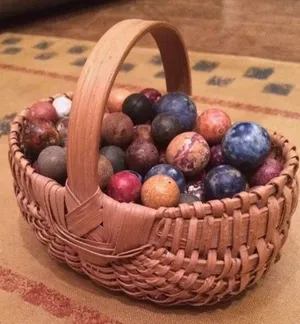Collectible marbles evoke youth
Do kids still play marbles? If memory serves, we drew a big circle in the dirt and used a shooter marble to knock smaller marbles out of the circle. The phrase “play for keeps” comes from the practice of keeping the marbles that a player knocked out of the circle.
Most of the marbles we see today are glass marbles. Vintage glass marbles are good collectibles. They are easy to display, recall our youth and are relatively inexpensive.
Marble games originated in ancient Rome and Egypt. The name comes from the use of marble stone and alabaster, which is white marble, to make the round game pieces. But real marble was expensive. By the 1800s, clay was the material of choice for marbles. These are the kind I collect.
Local potteries had their young apprentices making marbles in their spare time. A clay marble was made exactly the way you would make a marble if someone handed you wet clay. Small amounts were rolled between the palms of the hand until a round shape was formed. These small clay marbles dried quickly.
Unglazed marbles made from colorful clays were simply poured into pitchers or open jars for firing. Since they didn’t have glaze on them, they didn’t stick together or harm the jars. Glazed marbles were rolled in a flat tin of glaze and then fired on the kiln shelves next to the regular pottery offerings. If you look at glazed clay marbles, you will see round spots where they touched the shelf and other marbles. After firing, they were knocked apart and given away or sold for almost nothing.
In 1846, a German glass blower invented special scissors that could cut hot glass during the glass blowing process. He perfected the technique, added color to the glass and made the first glass marbles. They were an immediate hit. Glass marbles were perfectly round, allowing a marble player to more accurately predict where a marble would hit and roll. Later, hot dollops of glass were dropped onto metal plates, where steel rollers formed the round orbs. Bright colors and intricate patterns were created within the glass. Marbles are being made in virtually the same way today.
An expert marble collector can tell the old ones from the new ones by their size, color and design. But, because glass does not show its age in the same way as wood or metal, it’s best to buy old marbles from a reliable source until you are more familiar with collecting these amazing items. There are several marble game accessories that are fun to collect as well. Vintage board games, shooters, marble bags and other items will make your collection more interesting to display.


